Texas Style Smoked Beef Brisket
On June 11, 2019 (Updated September 06, 2022)
This post may contain affiliate links. Please read our disclosure policy.
Texas Style Smoked Beef Brisket is more than a simple recipe, it’s a process for melt in your mouth smoked brisket. All you need is salt, pepper, smoke, and time, and you’re on your way to eating the best beef brisket of your life.
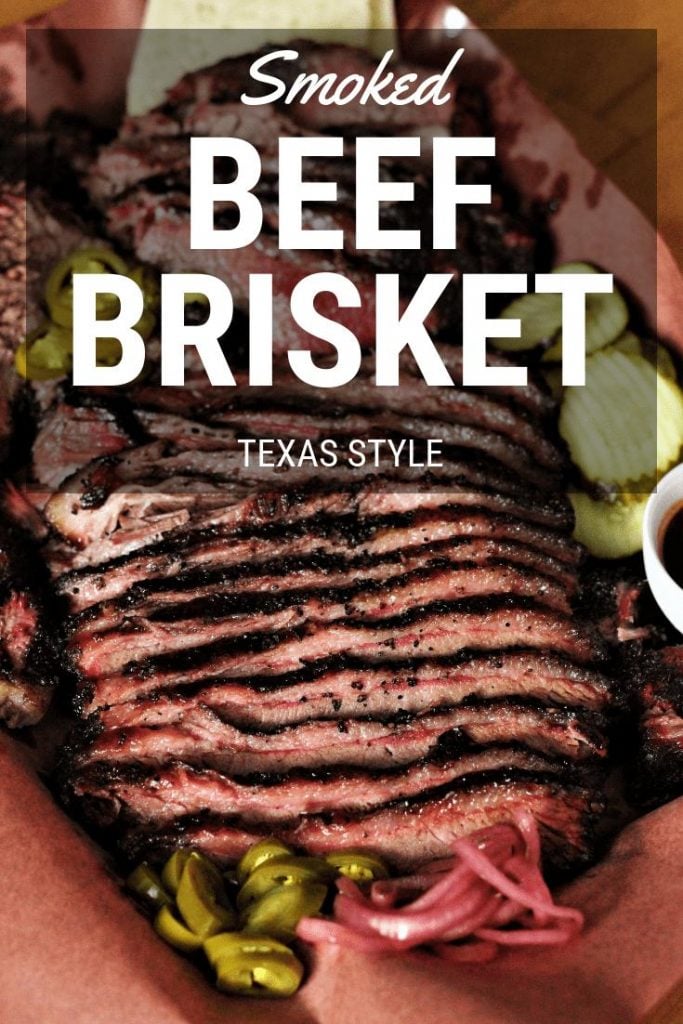
Smoked Brisket
I totally understand how intimidating it can be to smoke a huge, expensive brisket for the first time. That’s why I’ve tested and re-tested many different methods and recipes to help you achieve perfect results every time using a relatively simple process.
Once you try this juicy brisket, you’ll be itching for the next opportunity to smoke another one. BBQ (especially brisket) is something you have to learn by experiencing it yourself, so let’s jump in and give it our best go!
Tools Needed to Smoke Brisket
I have linked the products that I use when smoking my brisket below so you can see exactly what I’m using at home. Not all of these are necessary, but after smoking a bunch of briskets, I have found they make the job a lot easier!
- Smoker. I like to use my CampChef SmokePro, but any variety that can hold a steady temperature of 225 degrees F will work great.
- Large Cutting Board. You’ll need a big surface to slice your hunk of brisket on once it’s ready to serve.
- Meat Thermometer. The Thermapen Mk4 is the perfect thermometer for this brisket, but any reliable thermometer will do.
- Butcher Paper. This Texas style brisket is wrapped in butcher paper during the stall. You can pick up some Hey Grill Hey Peach Butcher Paper over at Patio Provisions today!
- Chef’s Knife. A good, sharp knife is necessary to slice your brisket. This Dahstrong Chef Knife is perfect for the job.
How to Smoke a Brisket
Smoking brisket isn’t hard, it just takes time, and lots of it! Follow the steps below to get the best smoked brisket of your life:
- Select your brisket. I have a full write up about choosing the perfect brisket in my Brisket 101 post. Here are the basics: Plan on purchasing a whole packer brisket with both the point and flat muscle included. The grade of your meat matters, prime beef will have more fat marbling. (This means more flavor and juiciness than a choice graded brisket!). Buy about 1/2 pound (or more) of brisket per person you are serving.
- Trim the brisket. Some Texans claim they don’t trim at all. At most of the top smokehouses, however, they do trim. This step is so important for how the final product will turn out. Spend the 20-30 minutes you need to trim it properly. I have step by step instructions (and pictures) for trimming your brisket in this post: How To Trim a Brisket. There is also a sped-up version in the video (below the recipe card) that will help you get a visual for a trimmed brisket.
- Season your brisket. Texas style is seasoned with only coarse salt and coarse black pepper. My only addition (and this is personal preference, you can skip it if you’re a purist) is to add garlic powder as well. It doesn’t really change the flavor or take away from that amazing smoked beef, but adds a little extra layer of goodness.
- Get Smoking! Use a nice hardwood in your smoker. I used oak as the base wood with a little bit of cherry mixed in. The goal here, whatever type of smoker you are using, is consistent heat and a steady flow of thin blue smoke.
- Wrap the brisket. This is one of the most crucial steps, in my opinion, to achieving that super juicy tender brisket with that killer dark caramelized bark. Opinions differ between using foil and peach butcher paper, but for this recipe I am fully converted to the butcher paper after years of using foil. My briskets have never had a better smoke flavor and a more delicious bark.
The brisket gets wrapped up like a present, folding edge over edge until it is fully sealed. Return the brisket to your smoker with the folded edges down and continue smoking at 225 degrees F until the internal temperature of your brisket reaches 202 degrees F at the thickest part (make sure your thermometer is in the meat, not fat).
- Rest your smoked brisket. DO. NOT. SKIP. THIS. STEP. Resting your brisket allows so many of those hot and bubbly juices to settle down a little and redistribute to the meat. It also brings your brisket down to perfect slicing and serving temperature.
- Slice your brisket. I have a full post about slicing your brisket HERE. You want to slice your smoked brisket against the grain for maximum tenderness. But remember! There are two overlapping muscles and two different grain directions. You can split the point and flat sections and slice each individually against the grain before serving but that sometimes leaves pieces with no bark on top. Traditional Texas joints split the brisket down the middle, as close as possible where to point overlaps the flat, they then turn the point 90 degrees and slice it that way and then finish slicing the flat the opposite way. You will have some pieces where they grain isn’t perfect but if your meat is tender enough it won’t matter too much.
- Serve your gorgeously smoked brisket. In Texas joints when you order, you can request fatty or lean brisket. The fatty is the point and the lean is the flat. I like to tell my guests which slices are which so they can pick their favorite. The fatty is my personal preference, but I always grab a slice of the lean too because it has such an amazing smoke flavor! For an even more traditional experience, serve on a platter with butcher paper, lots of pickles, white bread, picked red onions, and pickled jalapenos. Sauce on the side. Always.
How Long to Smoke a Brisket
I wish I could tell you an exact time that smoking will take, but alas, that’s kind of the beauty of BBQ. It’s done when it is done.
For the initial smoke phase, I plan about 8 hours at 225 degrees F for my 12-13 pound briskets to reach 165 degrees F. However, your brisket will enter a phase in between 145 degrees F and 165 degrees F where the liquid evaporating from the surface of the brisket will cool it while your grill is trying to cook it. This is called the stall, and the time frame is different during this phase for every brisket I’ve ever cooked. This is where a good internal thermometer comes in.
The second phase (once it’s wrapped in butcher paper), can take anywhere from 5-8 hours. I usually plan an extra 2 hours for each of my brisket cooks because if it is done early, I can always set it in a cooler and allow it to rest for a while. If it is done late my husband gets hangry.
Bottom line: plan for anywhere from 12-18 hours to fully cook your brisket (this includes the initial smoke to 165 degrees and the wrapped smoke to get your meat up to 202 degrees Fahrenheit).
Tips for the Best Smoked Beef Brisket
Check out these pro tips to give you the upper hand when smoking your brisket:
- Mix your spices in advance. Mix your salt, pepper, and garlic in an old spice shaker container. Shake the spices out at about 2 feet above your brisket while seasoning. This will create a nice even layer of salt, pepper, and garlic across the entire surface of your brisket.
- Either side up cooks just fine! Many people argue whether you should cook your brisket with the fat side up or down when smoking. Guess what? I did two briskets, one up and one down. There was no difference in final product. Place it on there however you prefer!
- Don’t forget to rest! Resting your brisket is extremely important. I recommend resting your brisket for at least one hour. You can just leave it in the butcher paper and set it on a cutting board or baking sheet. If you need to rest your brisket for more than an hour, that is no problem! Simply wrap it in a towel (one you don’t mind sacrificing for tasty brisket) and set it in an insulated cooler. I’ve held briskets this way for up to 6 hours and they come out hot and perfect every time!
Variations for Smoked Brisket
Not all brisket methods are the same, and I often try different techniques to get the best results. Here are a couple of variations you can try:
- Slather! Some people like to use a binder to help the rub adhere to the brisket. My favorite is yellow mustard. This helps the seasoning stick, but the acidity also helps break down the surface of the meat and create a gorgeous bark. It’s not necessary, but worth a try to see if you like it!
- Wrap! I recommend wrapping in butcher paper, but foil is also an option. In fact, foil is the original Texas crutch to help push smoke dmeat through the stall. It’s still used in many BBQ joints. Your brisket may have a softer bark, but it will maintain a lot of moisture inside the meat itself.
- Temperature! I like low and slow for my briskets, but some people like the process to hurry a long a bit. You can try smoking at 275 degrees F to shorten the cook time. There’s no perfect formula to have a perfect time line, so keep an eye on the internal temp of your brisket.
Smoked Brisket Recipe
Watch the video below the recipe card and I’ll show you step-by-step how I make this smoked brisket at home. I’m on a mission to help you become the best backyard BBQer of your life, so head on over to YouTube, Instagram, or Facebook to get more recipes, videos, and tips from Hey Grill Hey. We can’t wait to hear from you!
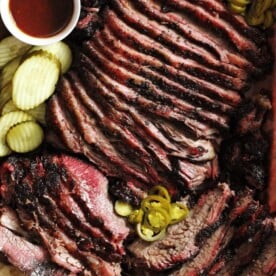
Texas Style Smoked Beef Brisket
Video
Equipment
- 1 Smoker I highly recommend this pellet grill!
Ingredients
- 1 12-14 pound whole packer brisket
- 2 Tablespoons coarse Kosher salt
- 2 Tablespoons coarse ground black pepper
- 2 Tablespoons garlic powder (optional)
Instructions
- Store your brisket in the refrigerator until you are ready to start trimming. Cold briskets are much easier to work with. Flip your brisket over so the point end is underneath. Remove any silver skin or excess fat from the flat muscle. Trim down the large crescent moon shaped fat section until it is a smooth transition between the point and the flat. Trim and excessive or loose meat and fat from the point. Square the edges and ends of the flat. Flip the brisket over and trim the top fat cap to about 1/4 of an inch thickness across the surface of the brisket.
- In a mixing bowl or empty spice container, mix the salt, pepper, and garlic. Share over the brisket to evenly distribute the spices on all sides.
- Preheat your smoker to 225 degrees F using indirect heat and hardwood smoke. Place the brisket on the smoker with the point end facing your main heat source. This is a thicker part of the brisket and it can handle the additional heat. Close the lid and smoke until and internal thermometer reads 165 degrees F (usually takes around 8 hours).
- On a large work surface, roll out a big piece of butcher paper (or foil) and center your brisket in the middle. Wrap the brisket by folding edge over edge, creating a leak proof seal all the way around. Return the wrapped brisket to the smoker, seam side down so the weight from the brisket crimps the edges of the paper wrap down tight.
- Close the lid on the smoker and, maintaining 225 degrees F, continue cooking until the internal temperature of the brisket reaches 202 degrees F in the thickest part of the meat (takes anywhere from 5-8 hours).
- Remove the brisket to a large cutting board and allow to rest for 1 hour before slicing. Slice both the point and the flat against the grain with a sharp knife and serve immediately.
Nutrition
Nutrition information is automatically calculated, so should only be used as an approximation.
**This recipe was originally published June 2017. It has since been updated and republished January 2019.
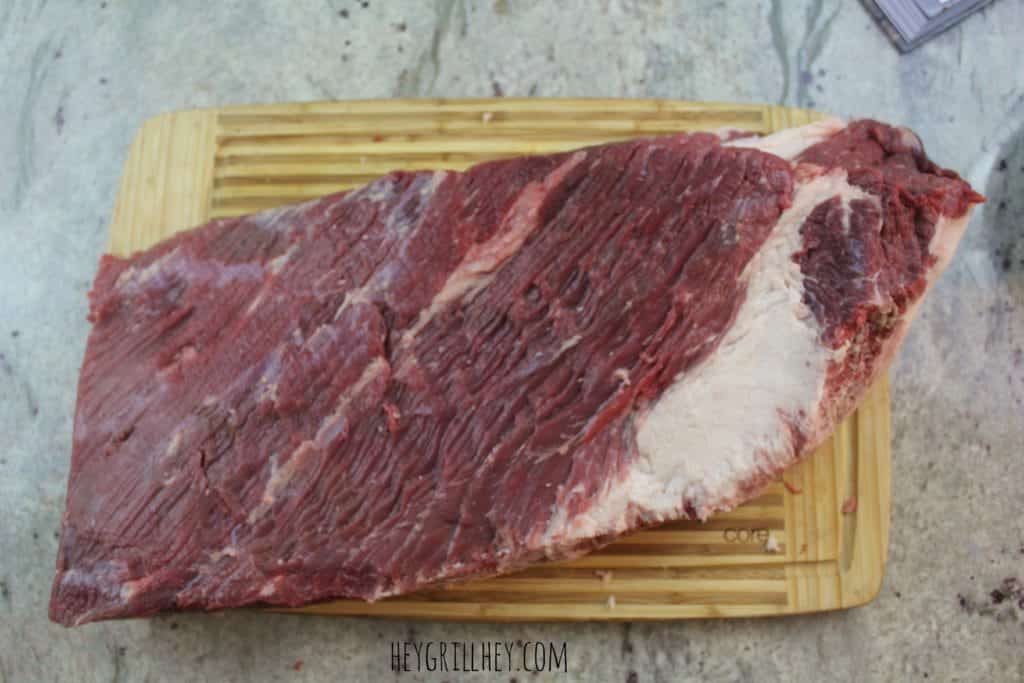
 The brisket gets wrapped up like a present, folding edge over edge until it is fully sealed. Return the brisket to your smoker with the folded edges down and continue smoking at 225 degrees F until the internal temperature of your brisket reaches 202 degrees F at the thickest part (make sure your thermometer is in the meat, not fat).
The brisket gets wrapped up like a present, folding edge over edge until it is fully sealed. Return the brisket to your smoker with the folded edges down and continue smoking at 225 degrees F until the internal temperature of your brisket reaches 202 degrees F at the thickest part (make sure your thermometer is in the meat, not fat).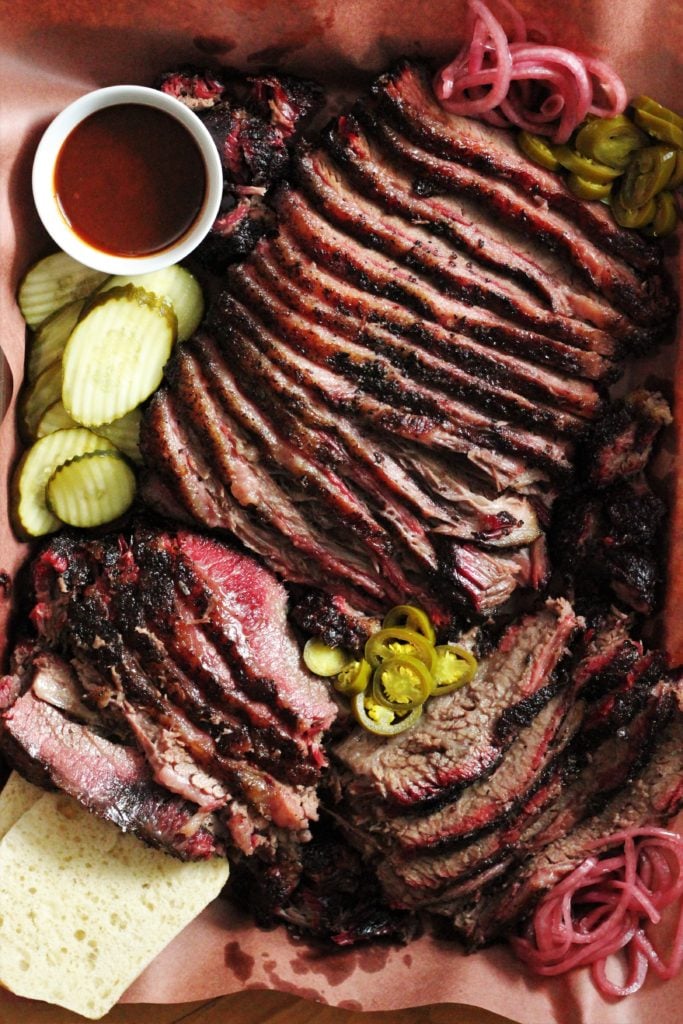
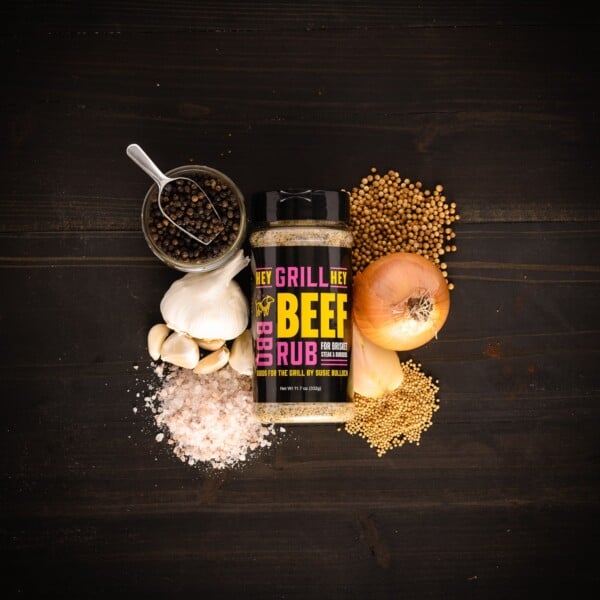


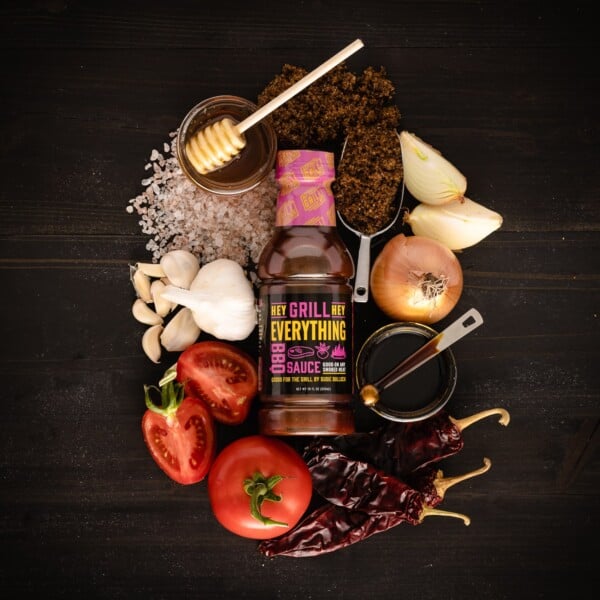
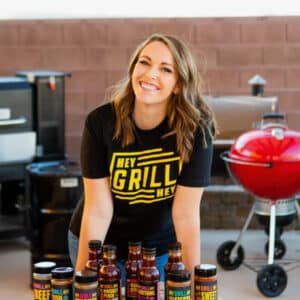
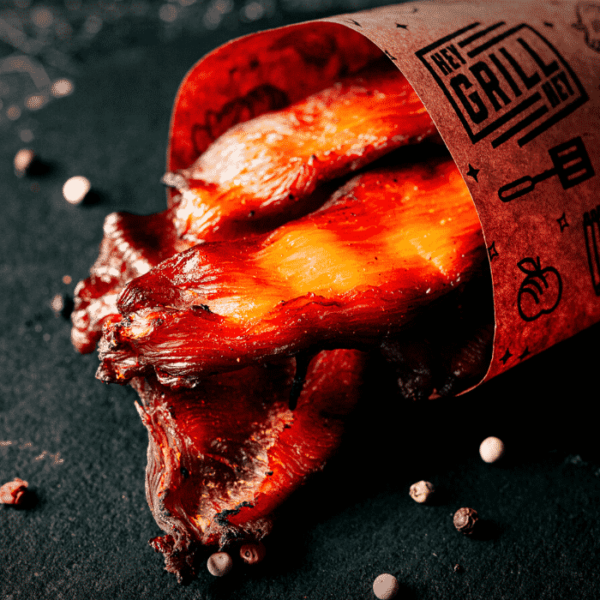
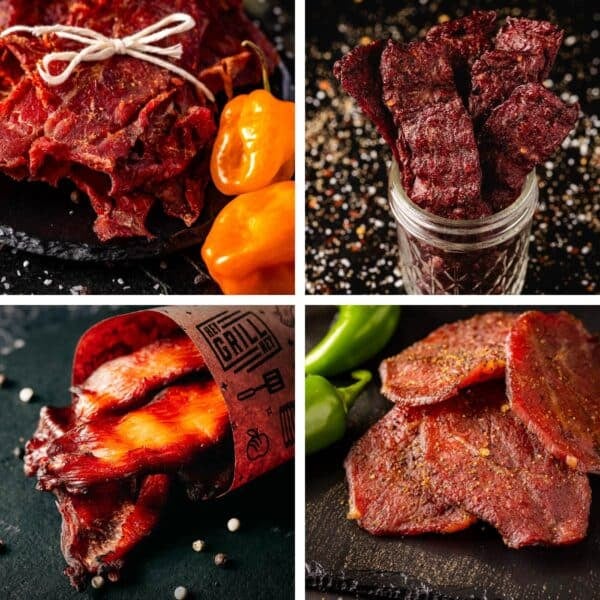

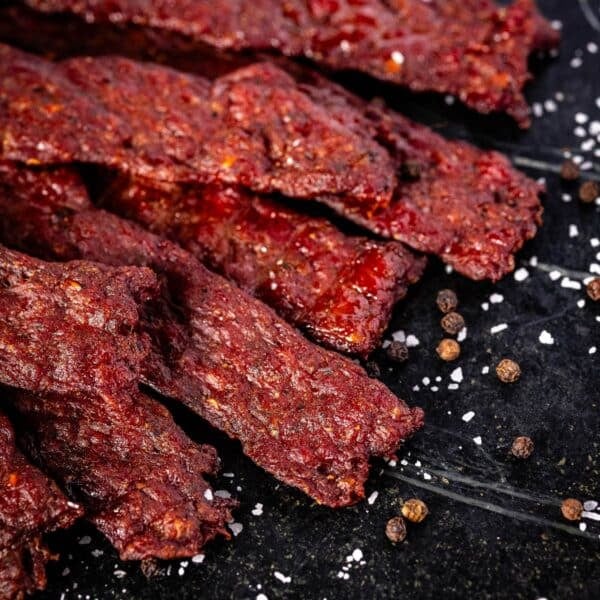





My smoker is too small for a whole brisket. Can I cut it in two and put one above the other. Probably thicken piece closer to the heat source.
For sure! You can even separate the point from the flat by cutting along the large vein of fat that runs between the two muscles and smoke them that way.
I am planning on buying an Expert grill charcoal water smoker from Walmart. Will that be big enough to hold that big of a brisket. I am wanting to try it out. Any help would be grateful
Hey Bobby- I’ve had several people report success fitting them on 22 inch kettle grills. I don’t have the exact specifications for your smoker, but it looks like about the same grill space.
When choosing your brisket, you should always, if possible, purchase a left-handed brisket and not a right-handed brisket. Why? A left-handed brisket is more tender. Most steers, cows and bulls, when laying down, rest on their left side. When they get up, they push with their right, front leg, thus exercising the right front leg more than the left front and adding a little more muscle to the right brisket. How do you know how to choose a left handed brisket? Well, ask some old Texas Brisket smokers like me. We might tell you the secret.
Doug,
Exactly how do you tell the difference between a left and a right. This makes since to me, but how do you tell? I have always been the Brisket king in my family, but tonight I have two that I am going to wrap for the very first time. I have always put them on , untrimmed and unwrapped, and my whole family will not even eat a a BBQ restaurant because mine are always better. I saw this on Facebook and thought it could be an improvement on my recipe. It just looked so good, I had to try it. As good as mine were I always felt like they had too much bark.
Hi doug…I just found this site and saw the comment about left and right sides briskets…wondered if you could share your knowledge on determining which side is which….
Do some research on the Traeger. There is an electronic setting that adjusts the “pause” which will help control the min/max/consistency of the temp. I borrowed a Traeger from a friend for a trial. His was too hot and required propping the lid open. He contacted Traeger and got the fix via e-mail. I bought one now and it works lime a champ.
I have a 30″ Masterbuilt electric smoker. Have you tried this recipe in one of these? Should I keep constant smoke on it? Looks and sounds delicious!
Hey Kurt! I would keep smoke on it until you hit the wrapping phase, then just set it for constant heat.
I used this technique with the same Masterbuilt smoker with tremendous results – best brisket I’ve ever done. I removed a few of the grills and had to basically cram it in there to begin with, but after it shrank a little it came out beautifully. I used a few more spices, (paprika, cayenne, blackened steak) and used a slightly higher temperature (235) once it was wrapped in foil. An inexpensive wired thermometer let me know when I hit the two key cooking points. For smoke, i used a mixture of mesquite, apple, and hickory chips that were soaked and added them ever 30-45 mins during the first 3 hours or so. My crowd prefers a lighter smoke flavour anyway, so no smoking tube required. Hands down best meal ever served at our cabin. Thanks again!
Do you leave the your temp. probe in the point or flat when looking for the butcher wrap temp and finished temp? If it is the flat, how do you know the point is done? If it is the point, how do you prevent the flat from drying out? Do you recommend finishing in the oven to save pellet fuel after wrapping?
Hey Brandon. Probe is in the point. I don’t worry about the flat drying out when I use prime brisket. The wrapping process also helps preserve a lot of moisture. I just continue on the smoker, especially when using paper because I feel the smoke still influences the bark. You can transfer to the oven if you are using foil and you want to though.
This recipe looks incredible. Is this typically a two day process? If yes, does the brisket go in the refrigerator between the first unwrapped smoke and then the wrapped smoke? If yes, does the 5-8 hours (wrapped smoke time) take this into account? We are super excited to try this for the 4th.
Hi Jen- the brisket doesn’t get refrigerated at all during the cooking process. It get removed from the smoker just long enough to wrap, and then goes straight back onto the smoker. I hope that helps!
Trying this for the 4th of July. Is 6 tablespoons of rub enough for a 12 to 14 pound brisket? When I cooked on the Memphis in May circuit, we used considerably more on a similar weight pork shoulder.
That’s how much I used to cover mine and it was totally sufficient. You can always make more, though.
I pretty much cook my briskets the same way. My questions:
Do you smoke fat side up or down? Once wrapped, up or down?
I found it doesn’t really matter if the day is up or down because my smoker is consistently indirect. If you have heat coming from underneath, it can be good to do fat side down and protect the flat a little.
I want to make this recipe so ad but I don’t have a smoker or grill. Would it be terrible if I tried it in the oven?
Hey Cheryl- this recipe was specifically written for a smoker. You technically could use the oven, but the brisket would be missing a lot of flavor from the smoke. There are some amazing oven brisket recipes out there that may yield you better results than trying to adapt this one.
I have a marvelous recipe for oven brisket (including the sauce ) that my daughter has used for a long time.
Young and old in our family love it. My email address is bbbwilkrson@ att.net. I will be happy to share it with
Cheryl if she will contact me. Bobbie Wilkerson
Hi Bobby
I would love your oven recipe if you will share
Thank you
I like your detailed step by step directions, will be so helpful this weekend as I try it out.
Thank you Anita! Good luck this weekend!